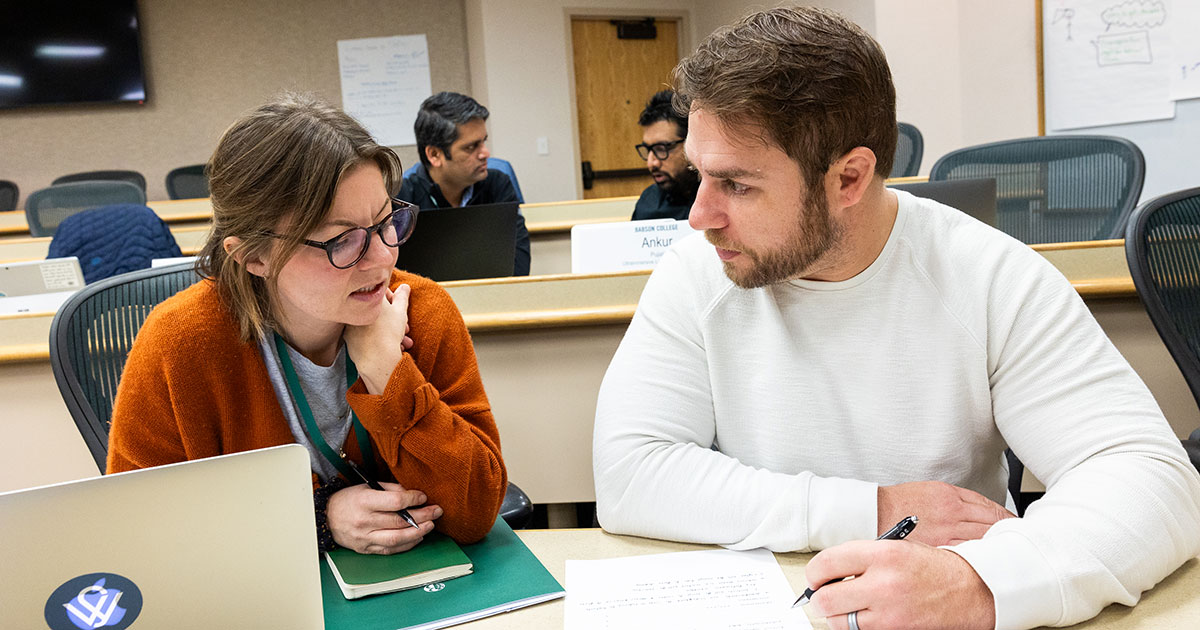A New Definition of Success

As a newly minted college graduate, Kelly Murphy Greeley had a plan. Her first years out of undergrad found her working at an investment firm, and later, moving to a consulting firm. By her own account, Greeley “really felt like I was on my way.” But, losing a dear aunt to cancer helped Greeley realize that her career could be more meaningful and fulfilling if she were working for a cause. She shifted gears, returned to the classroom to earn an MBA at Babson, and today works as a business analyst at Boston Children’s Hospital, where she helps physicians and their teams grow multidisciplinary clinics. Her business skills and entrepreneurial mindset help get the day–to-day work done, but Greeley’s real job satisfaction comes from knowing that her work gives patients and families improved access and a better experience while receiving care.
Greeley isn’t alone. American Express surveyed 2,184 adults in its Life Twist Study, finding that only 33% of people surveyed think “having a lot of money is the key to having a successful life,” ranking it 20th overall on a list of 22 contributing factors. In national surveys and in their career choices, Americans value meaningful work, fulfilling relationships, and greater work-life balance. Like Greeley, many are finding this holistic satisfaction in mission-driven careers in the nonprofit world.
Are nonprofits really so different?
The culture of nonprofits was once easy to describe: Change the world, and don’t worry too much about how you do it. But, as nonprofits borrowed methods and attitudes from fast-growing businesses, many of today’s social ventures run more like a for-profit enterprise than a traditional charity, focusing innovation and creativity on how they operate.
While similar in theory, for-profits and nonprofits are traditionally miles apart in how things get done. Getting people to work together in a hospital, university, or charity can be more difficult than within a company, since nonprofits lack the unifying simplicity of for-profit models that maximize income and minimize costs. “One of the challenges I’ve found in moving to nonprofits is that decisions often involve a number of people or committees,” says Greeley.
Change can take a little bit longer to implement, and you have to understand each stakeholder’s perspective and be prepared as best as possible for their questions and concerns.
What seems wasteful in a company (achieving consensus, for example) can seem necessary in a nonprofit, precisely because people are not there to maximize their personal bottom line. This is why people transitioning into nonprofits can be blindsided by the politics of a place—the carrots and sticks that enforce behavior in for-profit companies are absent, and filling that vacuum are more subtle, often hidden motivations and deterrents.
Nonprofits can be a great match for creative employees. The model of Entrepreneurial Thought and Action®—balancing action and innovation with a deep understanding of business fundamentals and analysis—works well in nonprofit environments, and many entrepreneurial characteristics can be particularly valuable, including:
- A willingness to experiment. Nonprofits are often open to trying new ways of operating. For example, squeezed by dwindling donations, some nonprofits are experimenting with new models of sustaining their mission. The Nature Conservancy partners with for-profit companies in sustainable projects, providing income while maintaining healthy ecosystems.
- A talent for selling a vision. Entrepreneurs both inside and outside of corporations are storytellers; they become experts at persuading others to invest in their vision. Internally and externally, nonprofits run on vision, so being able to skillfully sell the story and communicate the vision is an everyday part of nonprofit life.
- Resourcefulness. Entrepreneurs are used to doing more with less, and nonprofits have less (money, people, time, you name it). Finding creative solutions to problems is a mark of the entrepreneur, and nonprofits need people with the drive to do whatever it takes to achieve objectives.
- Seeking opportunity to change the status quo. Where others see inertia, entrepreneurs smell opportunity. This is true everywhere, from hugely profitable companies to nonprofits. For example, Zappos launched in 1999, changed how people buy shoes. TOMS, a company with giving at its core, changed the reason why people buy shoes when it came on the scene in 2006.
In the early days of a nonprofit career transition, there are a few simple things that can make the adjustment easier. Cheri Paulson, director of the Graduate Center for Career Development at Babson’s F.W. Olin Graduate School of Business, suggests getting out of your silo fast.
“Volunteer to serve on broad-based committees,” she advises. “If you get outside of your silo, you’ll learn quickly who your advocates are and how the culture works. You’ll learn the new language, which is critical, and influence key players collaboratively.”
It’s especially important to learn who the influencers are and how decisions are made. Nonprofits seek alignment and consensus. Always remember that nonprofit employees take some of their pay as intangible reward: pride, satisfaction, and the sense of meaning that brings talented people to work for something other than a paycheck.
Posted in Entrepreneurial Leadership, Insights






